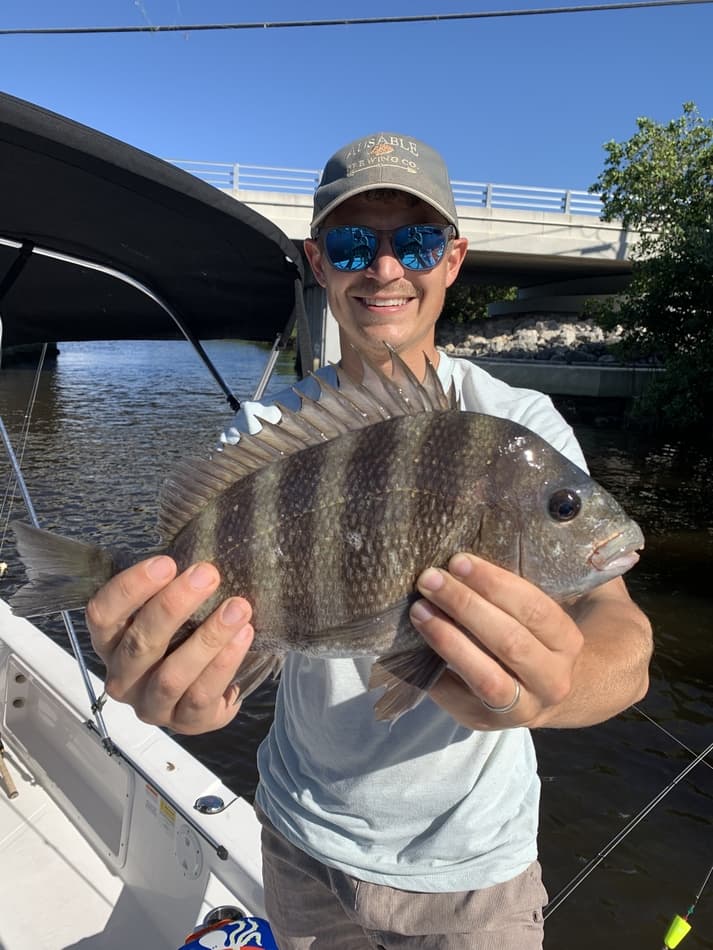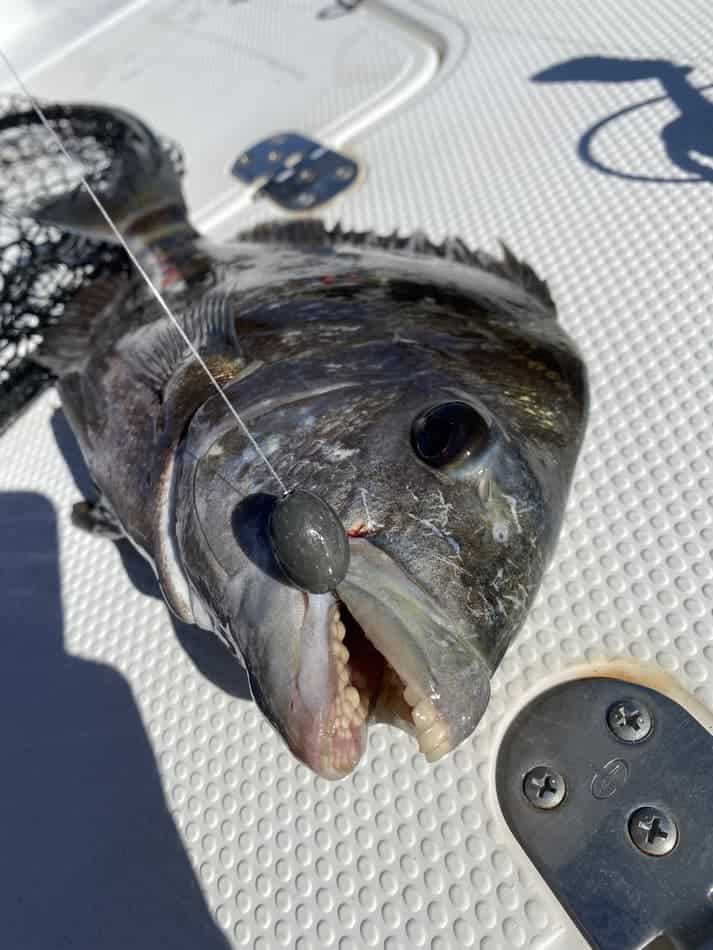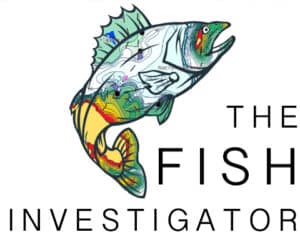
If you have never had the opportunity to catch Sheepshead you are in for a unique fishing experience like no other. Sheepshead are picky eaters and hard to hook, making for a fun fishing challenge.
How To Catch Sheepshead
Sheepshead are caught in 6-15’ of water by using small hooks and bait, including shrimp, crabs, or sand fleas. Cast your bait within 2 feet of a submerged structure such as pilings, rocks, or reefs, and pay close attention because Sheepshead are sneaky and can easily run off with your bait.
Sheepshead are a difficult fish to catch and are not frequently caught for many reasons. One of these reasons is that the techniques used to fish for Sheepshead are completely different from many other inshore or nearshore fishing techniques that are employed.
The first thing to understand when targeting Sheepshead is that they have extremely small mouths making it necessary to use small hooks and bait. I recommend using a #1 to #2 size hook for optimal hookups, but it can vary slightly depending on the size of the Sheepsheads that you are targeting.
Sheepshead prefer small baits, including small shrimp (or cut up), sand fleas, fiddler crabs, clams, and oysters. While you are targeting Sheepshead, if you keep feeling taps without hooking up, there is a good chance your hook or bait is too big. The optimal bait size for Sheepshead is about the size of a quarter.
Sheepshead are known to steal your bait, so do not forget to keep your line tight. Any slack in the line and the Sheepshead will run off with your bait without you even knowing you had a bite.
Sheepshead are almost always found inhabiting waters within a couple of feet of submerged structures. Making sure your bait is within a foot of these structures will dramatically increase your odds of hooking up. If you are fishing in an area with heavy current, make sure that you have enough sinker weight to keep your bait within the proximity of the structure they are inhabiting. Though Sheepshead travel within the whole water column, they are often caught on the bottom to about halfway up to the surface. The depths in which they congregate also vary, but it seems that 6’-15’ is their sweet spot.
Sheepshead often congregate in schools, so if you hook up to one fish, have other anglers on the boat cast in that general vicinity to hook into the rest of the school. If you aren’t getting any bites after a couple of minutes and still have bait on the hook, head to another spot.
If you are really trying to increase your productivity fishing for Sheepshead, you can chum by throwing small chunks of bait into the water. If Sheepshead are present in the area you are fishing, you should know in a couple of minutes of fishing the spot.
Expert Tips On Catching Sheepshead
Live bait is best: Though Sheepshead can be caught on a long list of baits, you can increase your fishing productivity by getting your hands on some live bait. The most popular baits used for Sheepshead are Shrimp, Crabs, and Sand Fleas.
Sight fish them in clear water: When water clarity is high, Sheepshead can be sight fished. Once you locate a Sheepshead, attempt to make a cast as close to the structure they are inhabiting. Sheepshead are rarely skittish, so there is not much concern spooking them.
The smaller your bait, the better: Sheepshead have extremely small mouths making them incredible thieves when it comes to stealing your bait. Using small hooks and bait will dramatically increase hookups and lessen the chance of these striped bandits making off with your bait.
Don’t make your leader too long: Sheepshead are crafty fish that have a way of getting your bait off the hook without you even knowing. By fishing with a small leader, you increase your setup’s overall sensitivity, helping you feel the next bite and set the hook when you need to.
Braided line is essential: Here is another tip about increasing your rod setups sensitivity that is essential. Make sure you are fishing with a braided line and not monofilament. The braided line will dramatically increase overall sensitivity.
Bring your shovel to scrape off some barnacles: Sheepshead, like many other fish species, gets excited when there is chum in the water. One great way of chumming them up is taking a shovel or hoe and scraping barnacles off the side of a piling or dock. If any Sheepshead are around, you will see them dart into the cloud of barnacles for an easy meal.
Hide your hook: Making sure your hook is hidden within your bait is essential. If Sheepshead are suspicious of your bait, they will either slowly pick at it without touching the hook or completely forget about consuming it altogether.
Get close to the structure: Sheepsheads are known for staying within feet of the structures they inhabit. It is very important that you get your bait within 24” from the structure you are fishing.
Fishing the right tide: Sheepshead do not discriminate between a rising or falling tide but prefers to eat when there is moving water. Make sure you check the tides to see when would be the best time to get out on the water. Also, make sure the area that you are fishing has at least a moderate movement of water.
Listen for them: If you have never fished for Sheepshead, you probably think I am crazy for saying this, but Sheepshead can often be heard as they gnaw barnacles off the side of boats and pilings. This tip can be helpful when trying to locate Sheepshead, especially when water conditions are murky.
When Can You Catch Sheepshead?
Sheepshead are caught year-round, with October through April being the most productive time of year to target them. Sheepshead are caught throughout the day, but feeding slows down substantially after sunset.
Where Do You Catch Sheepshead?
Sheepshead are caught in the tropical, subtropical, and temperate zones in the Atlantic & Gulf of Mexico. Sheepshead is a coastal species of fish rarely venturing further than a couple of miles offshore.
During the summer months, large Sheepshead migrate out to shallow reefs.
In the winter months, they are known to inhabit shallower waters as they spawn. Sheephead are known to congregate heavily around docks, jetties, markers, and bridges.
Expert Tip: One great way to find Sheepshead hot spots is to look for any vertical structures with a heavy build-up of barnacles. Older docks, pilings, and markers typically hold more barnacles resulting in a better chance of them inhabiting these structures.
Here Are My Top 7 Sheepshead Fishing Hotspots
- Bridges
- Docks
- Markers
- Jetties
- Seawalls
- Piers
- Natural & Artificial Reefs
What Do Sheepshead Eat?
Though Sheepshead feed on some fish, their diet consists mainly of crustaceans. Sheepshead are always on the lookout for their next meal so getting to know their natural diet will help you understand what they are looking for.
Natural Sheepshead Diet:
- Crabs
- Oysters
- Clams
- Sand Fleas
- Shrimp
- Small Croaker
What Are The Best Baits To Catch Sheepshead?
Though sheepshead can be caught on a long list of baitfish and crustaceans, here are the top 5 baits to target them.
- Sand Fleas
- Shrimp
- Crabs
- Oysters
- Clams
Depending on the time of year, different baits work better in attracting Sheepshead. During the winter months, Sheepshead are known to prefer shrimp over other baits.
Can’t find bait? No problem! Sheepshead can be targeted using a list of artificial lures and baits.
Here Are My Top 3 Artificial Lures/Baits For Catching Sheepshead
- Gulp! Sand Crab Flea (Amber Glow): The Gulp Sand Crab Flea is a great artificial lure option if you are not able to get a hold of any live bait options. They can be hooked directly to #1 to #2 hooks that seem to work best when accompanied by a bottom sweeper jig. Since these Gulp lures have the famous scent dispersion technology, they don’t require jigging.
- Crusty Crab by Chasebaits (Mossy): The Crusty Crab by Chasbait is a fun artificial lure to use for Sheepshead. The Crusty Crab comes outfitted with a small weight, so it is not necessary to add any additional weight. Any addition to the weight will affect the natural fall of the lure, so it is recommended to fish as is. The best way to work the Crusty Crab is by retrieving the lure up to the top of the water and letting it sink. Most Sheepshead hit the lure on the fall.
- E-Z Shrimp by Fishbites: The EZ-Shrimp is an easy artificial bait option that can be a great option for young or beginner anglers. Fishbites are essentially a bubble gum like strip that replicates the smell of fish. Fishbites work best when fished with a small hook and sinker.
Best Fishing Tackle For Sheepshead
When fishing for Sheepshead, using the correct fishing tackle will dramatically increase your overall productivity on the water.
Best Fishing Rods For Targeting Sheepshead
Sheepshead are often targeted from a dock, kayak, or small to the midsize boat, so using a small to a midsize rod is recommended. When casting is not a key factor, the use of a shorter rod is typically recommended.
Shorter rods are more manageable and easier to handle especially when you are fishing on a small vessel. I recommend the 7’ medium weight fast action “Stellar Lite Fast Taper Spinning rod” by Star Rod is an excellent rod for targeting Sheepshead. The length of Stellar Lite is great for making short to moderate casts, and the medium rod weight is perfect for fighting these aggressive fish.
One great benefit when purchasing a Star Rod is that their rods come with a lifetime warranty.
Best Fishing Reel For Sheepshead
When targeting Sheepshead, a 2500 to 3000 size reel is optimal. Though Sheepshead have a dramatic initial bite, their stamina is not anything anyone would brag about, so a large line capacity or heavy drag is unnecessary. I have always enjoyed fishing the Daiwa BG 2500 and the Stradic 2500 when targeting Sheepshead.
Best Fishing Line For Sheepshead
The best fishing line for targeting Sheepshead is a lightweight braid. I recommend at least a 20lb braid that is abrasion resistant since you will be targeting these fish close to sharp structures.
Power Pro’s Super 8 Slick V2 is specifically designed with abrasion-resistant in mind making for a great line option for catching Sheepshead.
After a long day of fishing Sheepshead around pilings, I recommend removing 10’-15’ of the braid. Removing this line will lessen the chances of you losing a future fish because of weak points in the line caused by long day fishing near sharp structures.
Best Fishing Leader For Sheepshead
The best leader when targeting Sheepshead is 15lb to 20lb fluorocarbon. Fluorocarbon is abrasion-resistant and practically disappears when it hits the water. When targeting Sheepshead, long leaders are unnecessary so using 2’-3’ of fluorocarbon is ideal.
Best Hook Size For Sheepshead
The best hook size for Sheepshead is a #1 to #2, which is about ½ inch in diameter. Using small hooks is essential to stop Sheepshead from stealing your bait right off the hook.
Best Sinker Size For Sheepshead
The proper sinker size for Sheepshead ranges from ¼ ounce to 3 ounces depending on the depth being fished and the strength of the current.
Selecting the proper sinker size for Sheepshead is essential for success. If the weight is too small and there is a heavy moving current, your bait will quickly drift away from your fishing structure. Because of this, I typically err on the heavier side, using a 2 to 3-ounce weight.
Though many types of sinkers can be used, a sliding egg sinker works best. The sliding sinker allows the bait to move freely, giving your bait a natural presentation.
Let’s take a deeper look at how to catch Sheepshead by learning more about the species as a whole.
What Are Sheepshead
Sheepshead are coastal fish that inhabit the tropical, subtropical, and temperate waters. Sheepshead have a football-shaped body with black lateral stripes that start from their gill plate back towards their anal fin. Sheepshead have extremely sharp dorsal fins, so be sure to exercise caution when handling these fish.
Now the teeth of this fish are how the Sheepshead got its name. The teeth have the appearance of sheep’s teeth, often elongated and crooked. Sheepshead is often called many names, including convict, convict fish, saltwater bream, and sheep bream. Sheepshead received their nickname “convict fish” because of their ability to steal people’s baits and the fact that their stripes closely resemble prison uniforms.
The average Sheepshead is caught weighing in at 5 to 10 pounds and roughly 20 to 25 inches in length. The largest Sheepshead ever caught weighed in at over 21 pounds.
Are Sheepshead Good To Eat?
Sheephead are phenomenal to eat. The flesh is mildly sweet, firm, and moist with a white appearance. Sheepshead flavor is dependent on their overall diet. Fish caught inshore around oyster bars, and pilings eat more crustaceans, giving their meat a sweeter flavor.
Since Sheepshead have a large rib cage, the overall fillet size is low. If you are looking to have a fish fry, you may have to catch your bag limit to have enough fish for the whole family.
Some decide to skip the filleting and just gut the fish and cook it whole. I personally enjoy cooking Sheepshead in this manner since it increases the overall meal size and locks in the flavor.
Are Sheepshead High In Mercury?
According to the FDA, Sheepshead have low to moderate mercury levels coming in at .08 PPM, which is about half the mercury content of the frequently consumed mackerel.
As with any fish consumption, it is recommended to track your weekly mercury consumption to ensure you are not consuming more mercury than your body can process.
Are Sheepshead Related To Black Drum?
Sheepshead are not related to Black Drum. Sheepshead are in the Archosargus probatocephalus family, whereas the Black Drum is in the Pogonias Cromis Family.
The easiest way to distinguish the two fish is by observing their mouths. Sheepshead will have rows of elongated teeth just behind their lips, where the Black drum has pharyngeal teeth, which are often described as having a cobblestone appearance. Black Drum also has chin barbels which are whisker-like appendages that are located just below the fish’s mouth where Sheepshead does not.
Is Sheepshead Toxic?
Sheephead is not toxic. Like all fish, sheepshead carry some level of mercury that can have many negative effects on humans. It is always best to follow FDA recommendations regarding safe levels of mercury consumption.
Do Sheepshead Have Scales?
Sheepshead have large scales ranging from ¼” to ¾” depending on their size, giving them a rough leather-like texture.
Many anglers reframe from keeping Sheephead since their rough scales can make filleting difficult.
Do Sheepshead Have Teeth?

Sheepshead do have teeth that resemble sheep’s teeth. The top and bottom jaws of the fish are full with incisor-like teeth towards the lips and molars towards the back of the mouth.
The Sheephead use their teeth to gnaw at barnacles and other crustaceans that are growing on vertical pilings.
Sheepshead Size & Bag Limit
Sheepshead has varying size and bag limits depending on the state. Florida’s size and bag limits include a minimum size of 12” and the allowance of 8 fish per person. Always check regulations since they are open to change at any time without warning. Some States like Mississippi allow you to harvest up to 15 fish in a single day.
